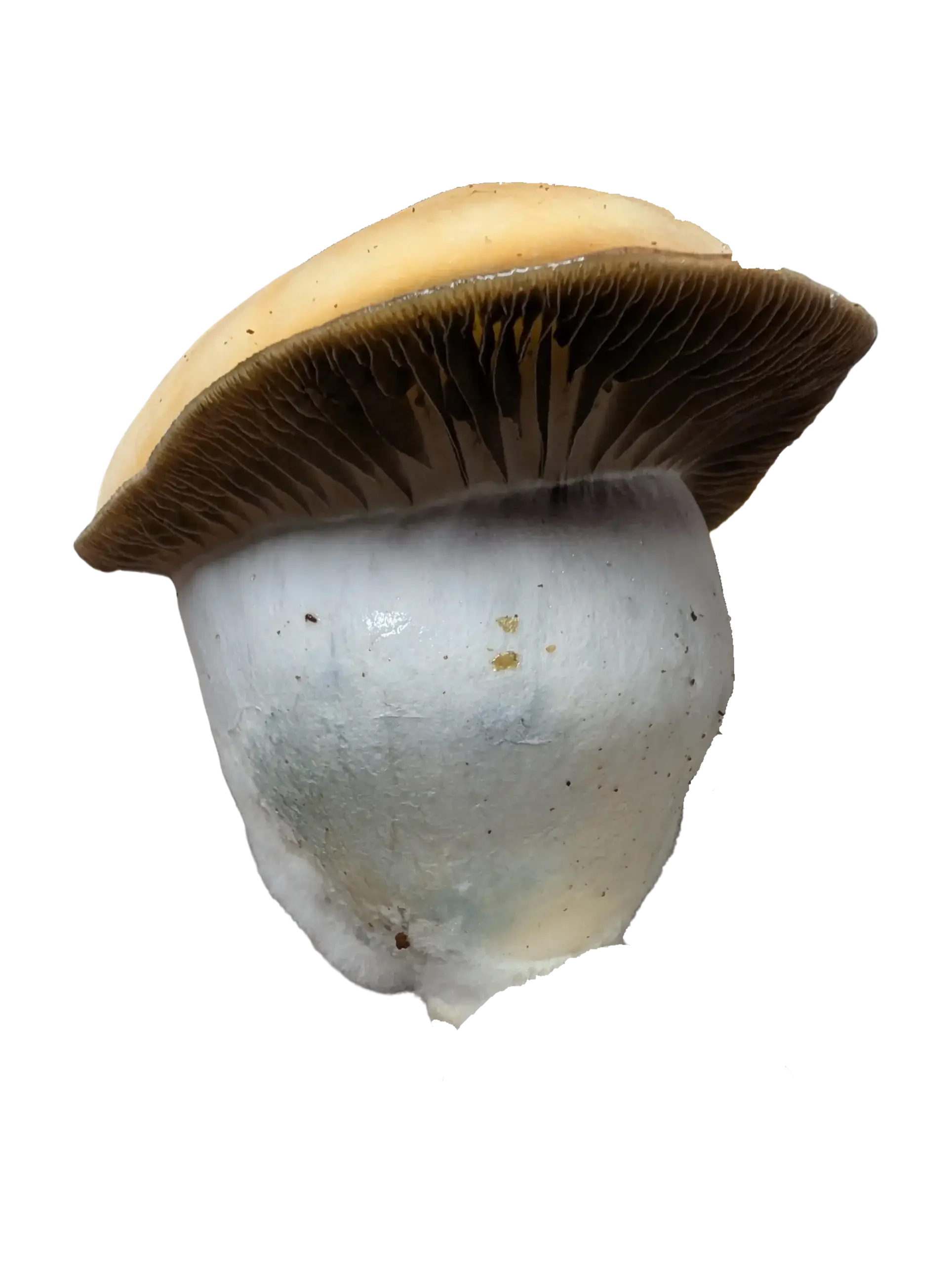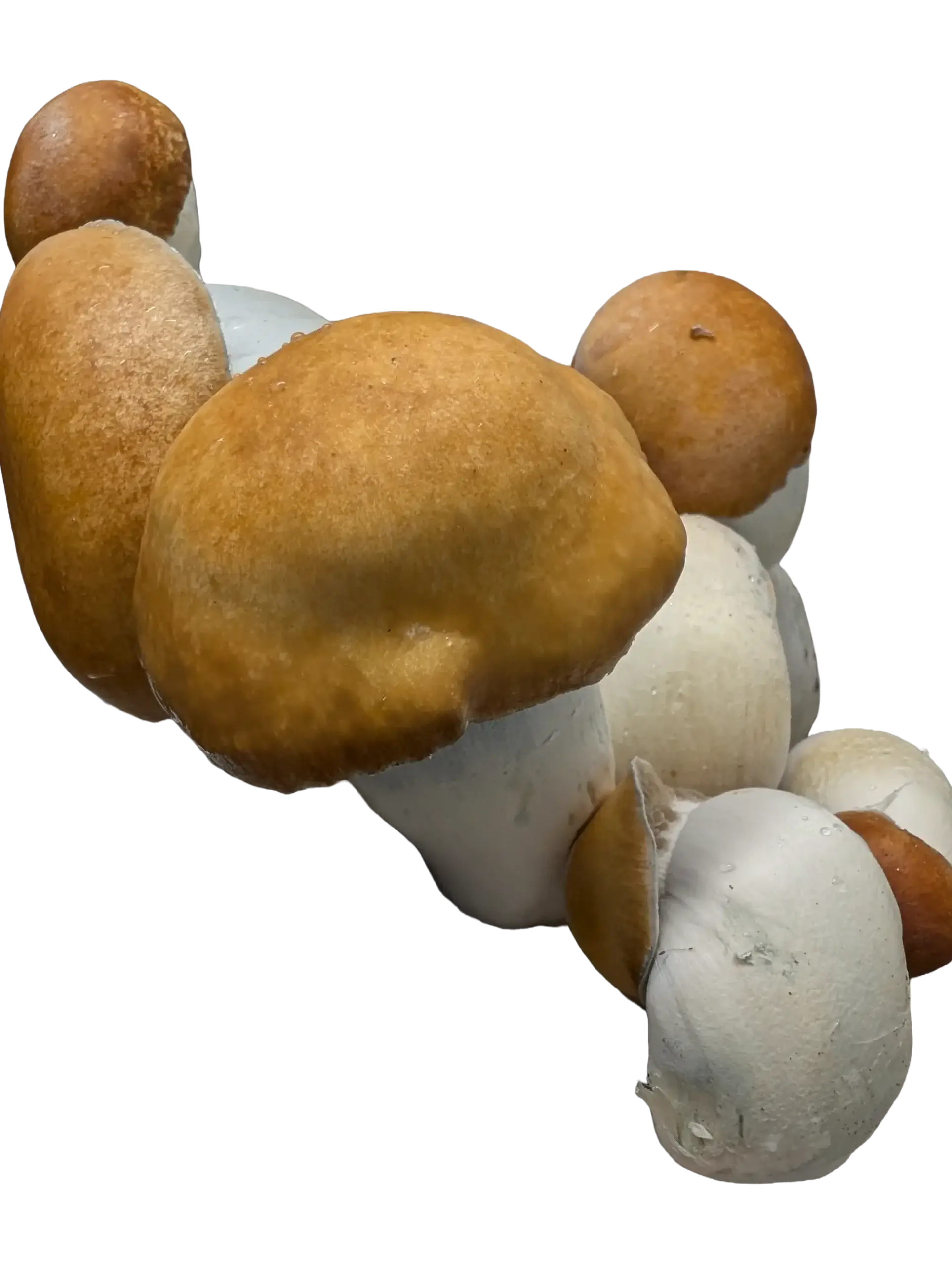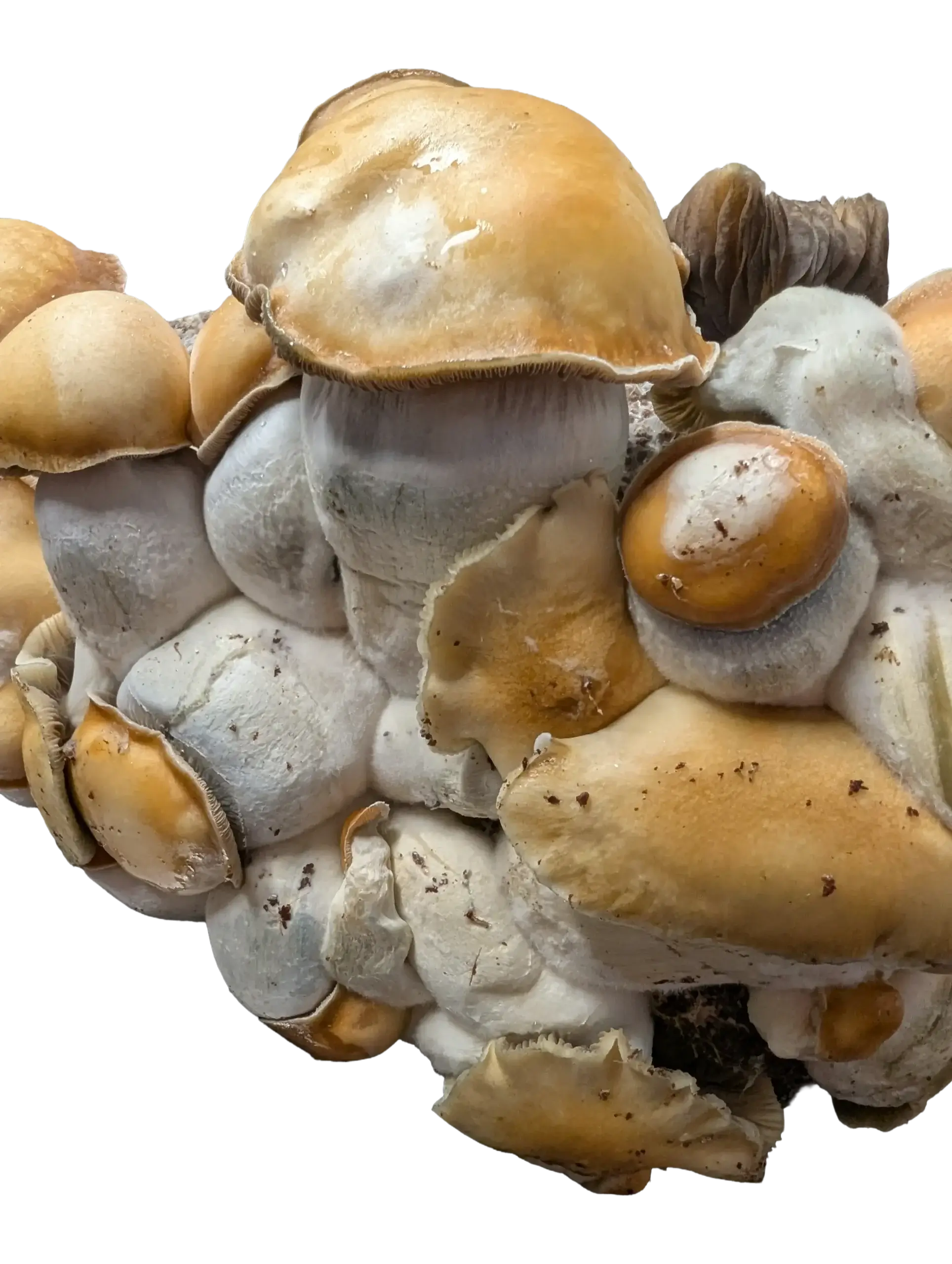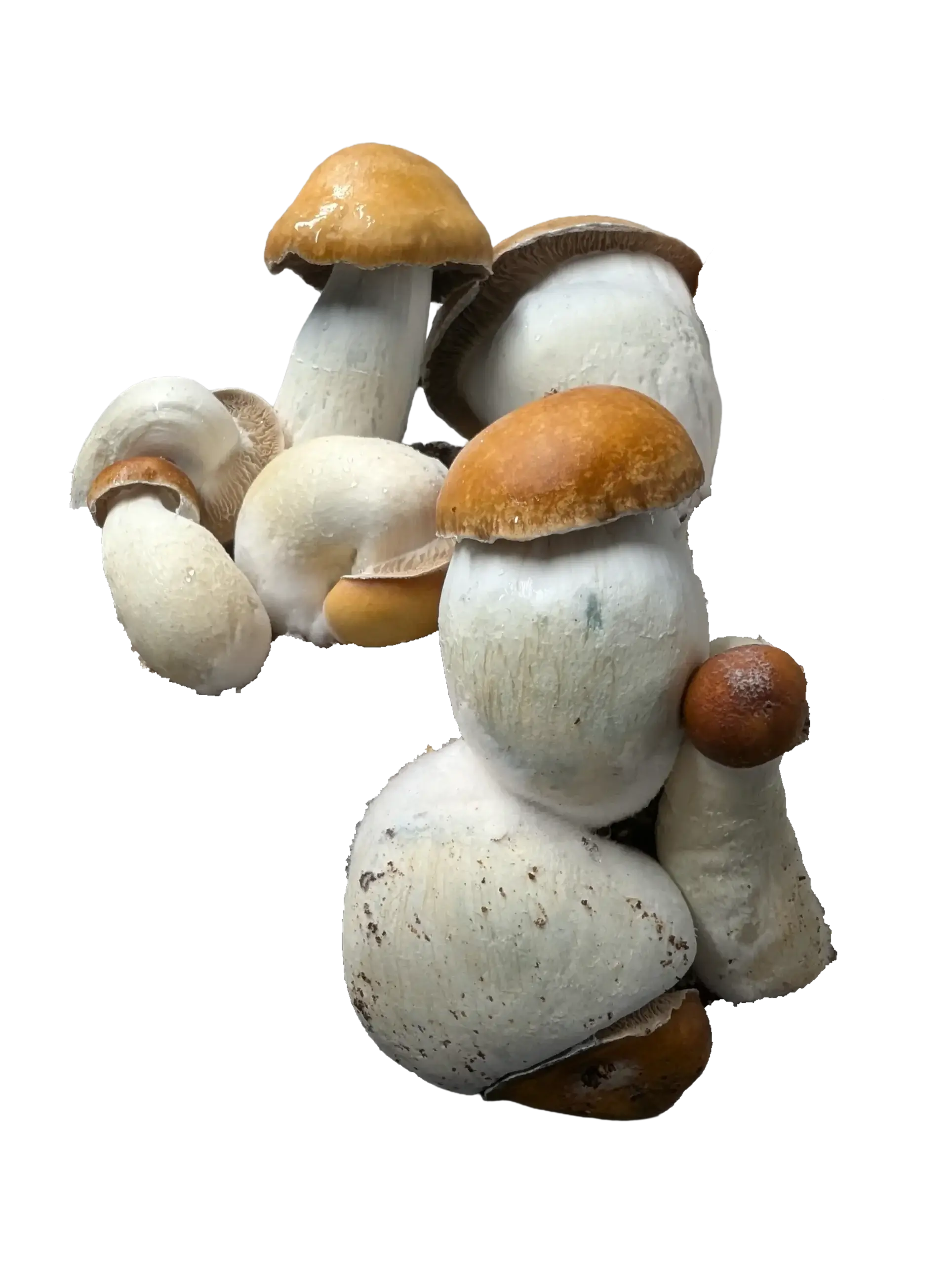What makes Squat Mac one of the most visually distinctive cubensis strains available today? This designer isolation combines the legendary genetics of the Melmac PE line with a unique, compact morphology that’s instantly recognizable. But here’s what sets it apart—Squat Mac delivers moderately elevated potency wrapped in a chunky, robust package that’s surprisingly forgiving for cultivators.
Squat Mac has earned its reputation through meticulous selective breeding by respected mycologists. These aren’t your typical lanky cubensis mushrooms—they’re dense, squat-bodied specimens with golden-brown caps and thick stems that resist contamination and handling damage better than most strains.
If you’re ready to grow a strain that combines visual appeal, reliable yields, and enhanced potency without the extreme difficulty of true Penis Envy cultivars, this comprehensive guide will walk you through everything you need to know. From understanding why Squat Mac colonizes so aggressively to mastering the simple techniques that produce those characteristic chunky flushes, we’ll cover it all.
The Squat Mac Legacy: Designer Genetics From Underground Legends
Squat Mac represents a milestone in modern mycological breeding—a rare squatty isolation traced directly back to the original Melmac PE line. This lineage is significant because Melmac itself is considered one of the most stable and desirable Penis Envy variants, known for combining PE genetics with improved sporulation and more reliable cultivation characteristics.
Through dedicated community selection work, Squat Mac has emerged as an exceptionally stable genetic line featuring the most compact, dense phenotypes from Melmac genetics. The selective breeding focused on isolating and stabilizing the characteristic squat morphology and uniform flush patterns that define this variety today. Years of refinement by passionate mycologists have locked in these desirable traits, creating a designer strain that consistently produces those iconic chunky, golden-capped specimens that collectors prize.

The name “Squat Mac” is wonderfully descriptive—referring to both the notably short but thick stems and the densely domed caps that, when mature, resemble the layered appearance of a Big Mac burger. This isn’t just creative naming; the morphology is genuinely distinct from standard cubensis varieties. Where typical cubes might grow tall and slender, Squat Mac produces chunky, compact fruiting bodies with substantial girth.
As a designer strain, Squat Mac does not occur in the wild. Every specimen traces back to careful selection and isolation work focused on aesthetic appeal, structural robustness, and moderately enhanced potency. This controlled breeding history means you’re working with genetics that have been refined specifically for cultivation success.
What Sets Squat Mac Apart From Other Cubensis Strains
Unique Morphology: The squat, compact stature with thick stems and densely domed golden-brown caps creates an instantly recognizable appearance that stands out from typical tall, slender cubensis varieties.
Melmac PE Lineage: Direct genetic connection to the original Melmac Penis Envy line provides moderately elevated potency while maintaining the cultivation ease of standard cubensis strains—offering a perfect middle ground for growers seeking enhanced experiences without extreme difficulty.
Aggressive Colonization: Squat Mac mycelium forms exceptionally strong networks and exhibits rapid colonization tendencies, often outpacing many other cubensis varieties and reducing the window of contamination vulnerability during substrate colonization.
Physical Resilience: The thick, sturdy fruiting bodies are significantly less prone to contamination or physical damage during handling compared to fragile strains, making this an excellent choice for cultivators still developing their harvesting techniques. Get Squat Mac spore syringes here to experience these robust genetics firsthand.
Essential Equipment and Substrate Preparation for Squat Mac
One of Squat Mac’s greatest advantages is its adaptability to standard cubensis cultivation methods. Whether you’re working with mushroom grow bags, monotubs, or shoebox containers, this strain performs consistently well across different setups. The aggressive mycelial network means Squat Mac isn’t particularly demanding about equipment sophistication—proper sterile technique matters far more than expensive gear.
For substrate preparation, Squat Mac thrives on the classic coco coir and vermiculite blend that works well for most cubensis varieties. A standard ratio of 650g coco coir brick, 2 quarts vermiculite, and appropriate water for field capacity creates an ideal growing medium. Some cultivators report excellent results adding a small amount of gypsum (1-2 tablespoons) to improve texture and provide calcium, but this is optional rather than necessary.
Critical Equipment for Squat Mac Cultivation
Sterilization Tools: A pressure cooker or pre-sterilized grain spawn is essential. Squat Mac’s aggressive colonization gives it an advantage over contaminants, but proper sterile technique during inoculation remains critical. Still-air boxes or flow hoods significantly improve success rates.
Substrate Containers: Mushroom grow bags work exceptionally well with Squat Mac due to the built-in gas exchange filters and durability. Alternatively, 6-quart monotubs or 54-66 quart larger tubs provide excellent results. The strain’s uniform flush patterns make it well-suited to standard monotub tek.
Environmental Control: A simple thermometer and hygrometer are sufficient—Squat Mac tolerates typical household temperature ranges (68-78°F) without requiring precise climate control. Basic misting and fanning 2-3 times daily maintains adequate humidity for fruiting.
Spawn Selection: Rye grain, brown rice, or even broke boi tek with brown rice works well. Squat Mac’s vigorous mycelium colonizes all standard grain types rapidly, typically fully colonizing quart jars in 2-3 weeks at room temperature.
Grain-to-substrate ratios can follow standard cubensis guidelines—a 1:2 ratio (one part colonized grain spawn to two parts substrate) produces reliable results, though some growers push to 1:3 ratios to stretch their spawn further. Squat Mac’s aggressive colonization handles either ratio effectively, typically reaching full substrate colonization in 7-12 days.
Comparing Squat Mac’s cultivation requirements to other designer strains? Explore our complete strain profiles for detailed comparisons of growing difficulty, potency, and yield characteristics across premium varieties.
The Squat Mac Inoculation Process: Setting the Foundation
Inoculation is where Squat Mac begins demonstrating its cultivator-friendly nature. The spores germinate readily and the resulting mycelium establishes quickly, often showing visible growth within 3-5 days of inoculation when maintained at optimal temperatures. This rapid start reduces the time your spawn jars remain vulnerable to contamination.
Standard sterile technique applies to Squat Mac inoculation just as with any cubensis variety. Working in a still-air box or in front of a flow hood, flame-sterilize your needle between each injection point, and use approximately 1-2cc of spore solution per quart jar of grain spawn. The key is distributing the inoculation points around the jar to encourage even colonization throughout the substrate.

Temperature management during colonization significantly impacts Squat Mac’s already impressive growth rate. Maintaining spawn jars between 75-80°F accelerates mycelial expansion, with many cultivators seeing full colonization in just 14-18 days. Room temperature (68-72°F) works perfectly fine and produces strong, healthy mycelium, though colonization may extend to 21-25 days.
One notable characteristic of Squat Mac mycelium is its density and brightness. Healthy colonization appears as thick, white, rope-like strands that quickly overtake the grain spawn. The mycelium often exhibits strong rhizomorphic growth patterns—those desirable thick, branching tendrils that indicate vigorous genetics. This aggressive colonization tendency means contamination struggles to establish itself even if minor breaks in sterile technique occur.
Squat Mac Inoculation Best Practices
Spore Solution Distribution: Use 4-5 injection points per quart jar, distributing them evenly around the sides and at different heights. This creates multiple colonization fronts that meet in the middle, accelerating full jar colonization and reducing the risk that contamination can establish before healthy mycelium dominates.
Post-Inoculation Positioning: Store inoculated jars in a dark or low-light area during colonization. While Squat Mac doesn’t require darkness, reduced light during this phase encourages the mycelium to focus energy on substrate colonization rather than premature pinning attempts.
Patience With Verification: Wait for 100% visible colonization before spawning to bulk. Squat Mac’s white, dense mycelium makes it easy to verify complete colonization—every grain should be covered in thick mycelial growth with no bare spots visible through the glass.
Shake and Break Timing: If using the shake and break technique to accelerate colonization, perform it when jars reach approximately 30% colonization. Squat Mac recovers quickly from this disruption and typically reaches full colonization 5-7 days faster than unshaken jars.
Spawning to Bulk Substrate: Where Squat Mac Really Shines
The spawning to bulk phase showcases why Squat Mac has become popular among both beginners and experienced cultivators. The strain’s vigorous mycelium aggressively colonizes bulk substrate, often achieving full colonization several days faster than standard cubensis varieties. This rapid colonization provides crucial protection against contamination during this vulnerable phase.
When breaking up fully colonized spawn jars and mixing with prepared substrate, aim for thorough distribution without over-handling. Squat Mac mycelium is resilient, but excessive manipulation can bruise the mycelium (causing blue coloration) and temporarily slow colonization. A gentle but complete mixing ensures even distribution throughout your growing container.
Mushroom grow bags work particularly well for Squat Mac cultivation. The bags’ built-in filter patches provide adequate gas exchange while maintaining humidity, and the compact fruiting bodies fit well within bag dimensions. For monotub cultivation, standard 6-quart shoeboxes or larger 54-66 quart tubs both produce excellent results. Squat Mac’s uniform flush patterns mean you’ll see pins emerging relatively evenly across the substrate surface.
Substrate depth should fall between 3-4 inches after mixing spawn and substrate. Squat Mac doesn’t require deep substrate like some strains—the compact fruiting bodies develop well with standard depths. After spawning to bulk, maintain the container in colonization conditions (no light, minimal air exchange) for 7-10 days until you see the substrate surface becoming uniformly white with healthy mycelium.
One advantage of Squat Mac’s aggressive colonization is flexibility with casing layers. While not strictly necessary, a thin casing layer (1/4 to 1/2 inch of plain coco coir or peat moss) can improve pinset uniformity and help maintain surface moisture. However, many cultivators skip casing entirely with excellent results—the choice depends on your preference and environmental conditions.
Mastering Squat Mac Fruiting Conditions
Initiating fruiting with Squat Mac is straightforward and follows standard cubensis protocols. Once substrate colonization is complete, introduce fruiting conditions by increasing fresh air exchange, lowering temperature slightly if possible, and introducing indirect lighting. The strain responds readily to these environmental cues and typically begins pinning within 5-10 days of introducing fruiting conditions.
Squat Mac tolerates a wide range of fruiting temperatures, making it forgiving for cultivators without precise climate control. The sweet spot falls between 68-75°F, with many home cultivators finding success at typical room temperatures. Unlike some finicky strains that demand narrow temperature ranges, Squat Mac fruits reliably across this spectrum, though cooler temperatures may slow development slightly while warmer conditions accelerate growth.

Humidity management matters more than precise temperature with Squat Mac. During pinning and early fruiting, maintain relative humidity between 90-95%. The thick stems and robust caps handle slight humidity fluctuations better than delicate strains, but consistent high humidity during development produces the best results. Once pins begin maturing into recognizable mushrooms, you can allow humidity to drift slightly lower (85-90%) without issues.
Fresh air exchange (FAE) is crucial for developing Squat Mac’s characteristic morphology. The compact, dense fruiting bodies can develop with moderate FAE, but inadequate air circulation may cause the stems to stretch more than desired, reducing the distinctive squat appearance. Fanning 2-3 times daily for 30-60 seconds, or using passive FAE with properly sized holes and polyfill, maintains the ideal balance.
Squat Mac-Specific Fruiting Parameters
Temperature: 68-75°F optimal range with excellent tolerance for typical household temperature fluctuations. Unlike temperamental strains, Squat Mac fruits reliably at room temperature without requiring heating mats or cooling systems, making it ideal for cultivators in varied climates.
Humidity: 90-95% during pinning and early development, can drop to 85-90% as fruits mature. The robust fruiting bodies resist abort and handle brief dry periods better than thin-stemmed varieties, though consistent moisture produces superior yields and cap development.
Fresh Air Exchange: Moderate to high FAE produces the best results. Fanning 2-3 times daily maintains the squat morphology, while inadequate air exchange causes stems to stretch vertically, reducing the characteristic compact appearance. Passive FAE through filtered holes works excellently with this strain.
Lighting: Indirect ambient light or 12-hour light cycles using standard LED or fluorescent bulbs provides adequate phototropic signals. Squat Mac doesn’t require intense lighting—normal household lighting near the growing area typically suffices to trigger proper fruiting and orientation.
Pinset density with Squat Mac often impresses first-time growers of this strain. The vigorous mycelium frequently produces numerous pins across the substrate surface, creating the potential for heavy flushes. However, not all pins will develop into mature mushrooms—some natural abortion occurs with any strain. The thick, sturdy pins that do develop tend to mature successfully, producing those characteristic chunky fruits.
One observation from experienced Squat Mac cultivators: the strain occasionally produces cluster formations where multiple mushrooms emerge tightly grouped together. These clusters showcase the compact morphology beautifully but can make harvesting slightly trickier. Gentle separation or harvesting entire clusters works equally well depending on your preference.
Ready to start your Squat Mac growing journey? Browse our full selection of premium spore syringes including Squat Mac and compare with other designer genetics for your next cultivation project.
Harvesting Squat Mac: Timing Is Everything
Harvesting Squat Mac at the optimal time preserves potency and prepares the substrate for subsequent flushes. The ideal harvest window occurs just before or immediately as the veil begins tearing—the thin membrane connecting cap edge to stem. With Squat Mac’s compact morphology, this veil break can be subtle compared to tall, stretched-out cubensis varieties, so careful observation is important.
The dense, domed caps of Squat Mac begin as tightly closed buttons and gradually expand as the mushroom matures. Unlike strains that flatten dramatically at maturity, Squat Mac caps often retain significant curvature even when fully mature. Watch for the cap edges beginning to lift away from the stem and the veil becoming translucent and tight—these indicate harvest readiness.
Once the veil tears, spore release begins quickly. While spore deposits don’t harm the mushrooms or subsequent flushes, they create a purple-black mess on caps and substrate that many cultivators prefer to avoid. The thick stems and robust caps make Squat Mac relatively forgiving if you harvest slightly early—the moderately elevated potency remains present even in mushrooms harvested before full maturity.

Physical harvesting technique with Squat Mac benefits from the strain’s sturdy structure. Grasp the mushroom firmly at the base where stem meets substrate, and twist gently while pulling upward. The thick stems resist breaking or leaving pieces behind in the substrate—a common frustration with more fragile strains. Clean harvests that remove the entire fruit body including the base promote better subsequent flush development.
After harvesting individual mushrooms or clusters, use a clean knife or scissors to trim any remaining stem material flush with the substrate surface. These “stumps” can prevent proper pinning in those locations during later flushes. The bluish bruising that appears where you cut is normal and indicates psilocin oxidation—it’s a hallmark feature of psilocybin-containing mushrooms and not a cause for concern.
Squat Mac Harvest Indicators
Veil Tension: The membrane connecting cap to stem becomes translucent and stretched tight across the gills just before tearing. With Squat Mac’s compact form, this membrane is often shorter than on tall varieties, so check carefully rather than waiting for obvious separation.
Cap Expansion: The densely domed caps begin lifting at the edges and may flatten slightly, though they typically retain more curvature than standard cubensis strains even at full maturity. Golden-brown coloration intensifies as mushrooms mature.
Bluish Bruising: Mature specimens often display blue-green bruising around cap edges and on stems where handled—this oxidized psilocin indicates the alkaloid content that contributes to Squat Mac’s moderately elevated potency. More bruising generally correlates with higher psilocybin content.
Stem Firmness: The characteristically thick stems remain very firm and dense even at full maturity. Unlike hollow-stemmed varieties that soften noticeably when ready, Squat Mac maintains structural integrity throughout development, making timing based on veil status more reliable than stem texture.
Troubleshooting Common Squat Mac Growing Problems
Despite Squat Mac’s forgiving nature and aggressive growth characteristics, cultivators occasionally encounter challenges. Understanding common issues and their solutions helps ensure successful cultivation from spore to harvest.
Excessive Stem Elongation (Most Common Issue)
While Squat Mac genetics favor compact growth, inadequate fresh air exchange can cause stems to stretch vertically, losing the characteristic squat appearance. This isn’t contamination or a problem with genetics—it’s simply the mushrooms seeking oxygen by growing taller to reach better air circulation.
Solution: Increase fanning frequency to 3-4 times daily, ensuring vigorous air movement across the substrate surface. If using passive FAE in monotubs, verify that filter holes are properly sized and not clogged with excessive polyfill. Within 24-48 hours of improving FAE, new pins should develop with noticeably shorter, thicker stems. Existing elongated fruits can still be harvested normally—they’re perfectly viable despite not displaying ideal morphology.
Cluster Overlapping and Difficult Harvesting
Squat Mac’s vigorous pinning sometimes creates dense clusters where multiple mushrooms grow tightly pressed against each other. While visually impressive, these clusters can be challenging to harvest individually and may develop moisture pockets between overlapping caps that increase contamination risk.
Solution: During the pin stage, thin out excessive clustering by gently removing some pins with sterilized tweezers, leaving 1-2 inches of space between remaining pins. This improves air circulation and makes harvesting much easier. Alternatively, harvest entire clusters as single units by twisting and pulling at the base where all stems connect—Squat Mac’s sturdy structure makes this approach very effective.
Slower Than Expected Second and Third Flushes
While first flushes from Squat Mac typically perform excellently, some cultivators report that subsequent flushes take longer to develop or produce smaller yields than anticipated. This often results from substrate nutrient depletion or inadequate rehydration between flushes.
Solution: After harvesting each flush completely, rehydrate the substrate by bottom-soaking (for tubs) or misting heavily (for bags) until the substrate returns to field capacity moisture levels. Consider applying a light casing layer of fresh coco coir after the first flush to provide additional moisture retention and nutrients. Maintain colonization conditions (reduced FAE, darkness) for 3-5 days after rehydration before reintroducing fruiting conditions. This “rest and recovery” period allows the mycelium to redistribute resources before pushing another flush.
Premature Mushroom Abortion
Small pins that stop developing and turn dark at the cap indicate aborted mushrooms. While some abortion is normal with any strain, excessive aborts suggest environmental stress. Squat Mac’s robust genetics typically resist abort, so significant abortion rates point to correctable issues.
Solution: Verify environmental parameters are within range—aborts commonly result from humidity dropping too low (below 80%) during pin formation or dramatic temperature fluctuations. Increase misting frequency and check that your growing container maintains consistent temperature. Aborted pins can be harvested and consumed (they’re still potent), and once conditions improve, healthy pins typically emerge during the next flush cycle.
Comparing Squat Mac to Other Premium Cubensis Varieties
Understanding how Squat Mac compares to other popular strains helps cultivators choose the right genetics for their goals and experience level. This designer isolation occupies an interesting middle ground—more potent and visually distinctive than standard cubensis, yet more forgiving than notoriously difficult varieties.
When compared to Albino Penis Envy (APE), Squat Mac offers several advantages for less experienced growers. While APE produces extremely potent fruits with striking albino appearance, it’s known for slow colonization, minimal sporulation, and demanding cultivation requirements. Squat Mac provides moderately elevated potency similar to APE while maintaining the rapid colonization and generous spore production typical of standard cubensis. For cultivators seeking enhanced experiences without extreme difficulty, Squat Mac represents a more accessible alternative.
The DCM 95 strain offers another interesting comparison point. DCM 95 focuses on consistent yields and reliability rather than extreme potency or unique morphology. Where DCM 95 excels at producing uniform, predictable flushes ideal for beginners, Squat Mac adds visual interest and moderately enhanced potency while maintaining similar ease of cultivation. Both strains handle standard cubensis growing conditions excellently, making the choice largely one of aesthetic preference and desired potency level.
For cultivators interested in visually striking genetics, Albino Bluey Vuitton provides an alternative designer option. This strain emphasizes leucistic (pale, cream-colored) fruits with heavy blue bruising. While Albino Bluey Vuitton offers unique coloration, Squat Mac’s compact morphology and golden-brown tones create equally distinctive fruits with different visual appeal. Both qualify as designer strains requiring similar cultivation skills, so the preference comes down to whether you want pale, heavily bruising fruits or compact, chunky golden specimens.
In terms of growing difficulty, Squat Mac sits comfortably in the beginner-to-intermediate range. The aggressive colonization and tolerance for standard cubensis conditions make it accessible to newer cultivators, while the designer genetics and moderately elevated potency appeal to experienced growers seeking something beyond basic strains. This versatility contributes significantly to Squat Mac’s growing popularity.
Multiple Flushes and Long-Term Productivity
Squat Mac substrates typically produce 3-5 productive flushes before nutrient depletion significantly reduces yields. The first flush is usually the largest and most uniform, showcasing the strain’s characteristic compact morphology most clearly. Subsequent flushes may produce slightly fewer mushrooms or fruits with minor morphological variation, but the thick stems and domed caps remain distinctive across all flush cycles.
Between flushes, proper substrate care maximizes productivity. After harvesting all mature mushrooms from a flush, allow the substrate to rest for 2-3 days with reduced misting and FAE. This recovery period lets the mycelium redistribute nutrients and prepare for the next fruiting cycle. Following this rest, rehydrate the substrate thoroughly—either by dunking entire blocks/cakes or by heavy misting until moisture levels return to field capacity.
Some cultivators report that adding a thin casing layer between flushes rejuvenates Squat Mac substrates and improves subsequent pinsets. A 1/4 inch layer of fresh, pasteurized coco coir provides moisture retention and a small nutrient boost. While not necessary, this technique can extend productive cultivation beyond three flushes for growers seeking maximum yield from their substrate.
Contamination risk increases with each flush cycle as the substrate ages and the protective mycelial network weakens. By the fourth or fifth flush, green molds or bacterial contamination may begin appearing on the substrate surface. At this point, most cultivators consider the grow complete and prepare fresh substrate for the next cultivation round rather than fighting advancing contamination.
Storage and Preservation of Squat Mac Mushrooms
Proper post-harvest handling preserves the moderately elevated potency that makes Squat Mac desirable for research purposes. Fresh Squat Mac specimens contain high moisture content (approximately 90% water) and deteriorate rapidly without proper drying. For long-term preservation, thorough desiccation is essential.
The thick, dense stems and caps of Squat Mac require more drying time than thinner cubensis varieties. Using a food dehydrator set to 95-105°F provides the most reliable drying method, typically requiring 6-10 hours depending on fruit size. The mushrooms are properly dried when they feel “cracker dry”—snapping cleanly when bent rather than bending flexibly. Any remaining moisture can lead to degradation during storage.
For research microscopy work, properly dried specimens can be stored in airtight containers with desiccant packets in cool, dark locations. Glass jars with tight-sealing lids protect against moisture reabsorption and light exposure, both of which degrade psilocybin content over time. Vacuum sealing provides additional protection for long-term storage extending beyond several months.
The bluish bruising that appears on fresh Squat Mac mushrooms is normal and indicates psilocin oxidation. This discoloration doesn’t impact the specimen’s quality for microscopy research. However, black or green discoloration suggests mold growth and compromised specimens that should not be preserved for research purposes.
Where legally permitted for research purposes, properly stored dried Squat Mac specimens maintain their characteristics for 6-12 months with minimal degradation when kept in ideal conditions. Beyond one year, gradual potency reduction becomes more noticeable, though properly stored specimens remain viable for microscopy studies for extended periods.
Ready to Start Your Squat Mac Growing Journey?
Experience the unique genetics that combine Melmac PE lineage with beginner-friendly cultivation characteristics. Squat Mac offers moderately elevated potency, distinctive compact morphology, and reliable results that make it perfect for both novice and experienced cultivators seeking something beyond standard cubensis varieties.
Final Thoughts: Mastering the Squat Mac Experience
Squat Mac represents modern mycological breeding at its finest—a thoughtfully crafted strain that delivers visual appeal, enhanced potency, and cultivation reliability in one compact package. The work of Mindful Myconaught, TKK, and Basidium Equilibrium has created genetics that make designer strain cultivation accessible to growers still developing their skills while providing enough distinctiveness to satisfy experienced cultivators.
The key takeaways for Squat Mac success are straightforward: maintain proper sterile technique during inoculation, provide adequate fresh air exchange during fruiting to preserve the squat morphology, and harvest just before veil break to maximize quality. The strain’s aggressive colonization and forgiving nature handle minor technique imperfections well, making it an excellent choice for cultivators ready to move beyond basic strains but not yet prepared for notoriously difficult varieties.
For microscopy researchers, Squat Mac spores showcase the careful selection work that created this strain. The genetics remain stable across generations, consistently producing those characteristic chunky fruits with golden-brown caps and thick stems. Whether you’re documenting morphological characteristics for research or simply appreciating the aesthetic appeal of well-bred cubensis genetics, Squat Mac delivers impressive results.
Remember that cultivation laws vary by jurisdiction, and these techniques are provided for educational and research purposes only. Always verify local regulations regarding cultivation of psilocybin-containing species before beginning any mycology project. Where legally permitted, Squat Mac offers an excellent opportunity to study a designer cubensis strain that balances accessibility with distinctive characteristics.
The mycology community continues developing new isolations and refining existing genetics, but Squat Mac has already secured its place as a modern classic. Its combination of reliable cultivation, unique morphology, and moderately enhanced potency creates a strain that appeals across experience levels. Whether this is your first designer strain or you’re expanding an already diverse collection, Squat Mac spore syringes provide access to genetics that genuinely stand out from standard cubensis offerings.
Continue Your Mycology Journey
- Albino Penis Envy (APE) Spores – Explore the extremely potent genetics from the PE lineage with striking albino characteristics
- DCM 95 Spores – A reliable, consistent strain perfect for cultivators seeking predictable results and generous yields
- Albino Bluey Vuitton Spores – Designer genetics featuring leucistic coloration and heavy blue bruising for visual appeal
- Browse All Premium Spore Syringes – Explore our complete collection of cubensis varieties for every skill level
- Strain Profile Library – Compare characteristics, difficulty levels, and unique traits across dozens of cubensis strains
- Compare Squat Mac with Other Compact-Fruiting Varieties


